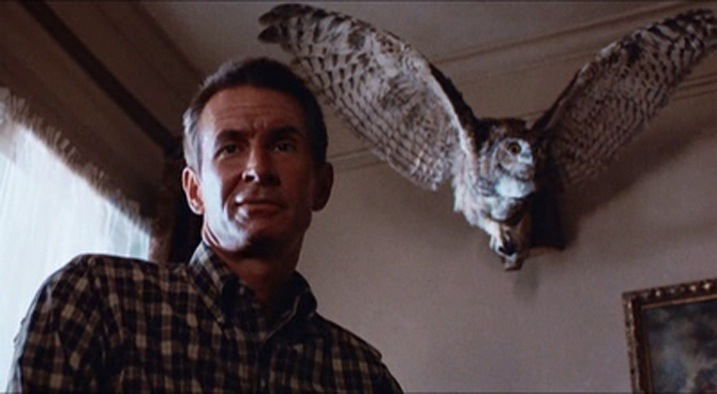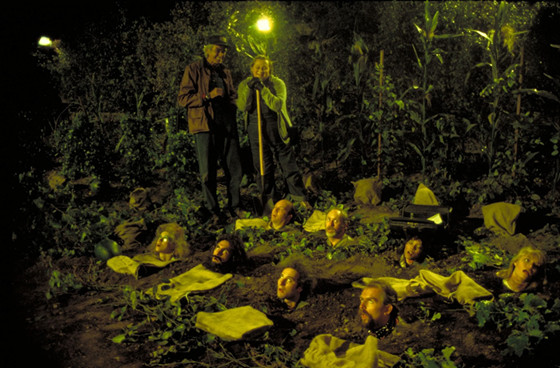
They say Roger Ebert appreciated all kinds of films and always judged films by their own intention and target demographic. That’s true, that’s what made him special but when you look at it, when it comes to horror films, Roger Ebert was not too easy to please. He rarely gave a horror film his “perfect” 4-star rating and it had to be something like “Halloween” or “The Exorcist” but just check out some slasher you enjoyed from the 80s and the chances are he gave it a negative review. He also strongly disliked “The Tenant”, was mostly lukewarm on “American Werewolf in London”, and “Scanners” didn’t do much for him.
Then again if he didn’t always give four stars to them, he enjoyed lots of horror films, some even much less known than the others. Checking out the iconic film critic’s reviews leads us to some overlooked gems. Here are ten of the fine horror films Roger Ebert enjoyed.
10. Psycho III (1986)

Ebert gave four stars to Alfred Hitchcock’s original masterpiece “Psycho”, saying it works on so many levels because it deals directly with our fears. The first sequel, released in 1983, was directed by Hitchcock student Richard Franklin. It did fine at the box office but received mostly negative reviews. The third installment, however, was directed by none other than Anthony Perkins himself. Ebert noted that perhaps no one understands Norman Bates more than Perkins.
”Psycho” is such a top-tier film that most sequels seem like cash-grabs by comparison. However, Psycho III is surprisingly fun. It’s stylish, full of black humor, has some genuinely great moments, and offers more plot-wise than the second film. The characters are so interesting that it’s easy to get immersed in the story. Perkins does a very capable job behind the camera and delivers some nice tributes to the first film. While it’s nowhere near the original, it doesn’t have to be. Fans of gory kills will also have plenty to enjoy. Interestingly, this is one of the films where Ebert disagreed with Gene Siskel. Though Ebert is known for disliking excessive violence, it was Siskel who found this film disturbing. In this case, it’s easier to side with Ebert.
9. Motel Hell (1980)

Originally meant to be a more serious film, “Motel Hell” director Kevin Connor suggested to producers to add dark humor and play it straight which resulted in a successful satire. It also helped it to not turn out as yet another copy of Texas Chainsaw Massacre, as both films were compared because of the chainsaw fight at the end of the movie. It’s as gory as you expect it to be because it’s hard to satirize the things without also showing them sometimes. While many critics were concerned with the violence in back-to-back slasher movies of the era, they all appreciated the sense of humor “Motel Hell” has about it.
Ebert, a man who sometimes gets so appalled by the violence in films that even gave “A Clockwork Orange” a low score, enjoyed it this time. He said “Motel Hell is not nearly as gruesome as the films it satirizes, and it finds the right stylistic note for its central characters, who are simple, cheerful, smiling, earnest, and resourceful cannibals” and he’s right! Rory Calhoun’s performance is particularly strong. Obviously one could do a little more with the material, the script could’ve been tighter and maybe Connor needed to be a little more confident behind the camera but it’s still so much fun. It had a cult following for a long time but seemingly doesn’t come up in conversations recently and that needs to change.
8. Eight Legged Freaks (2002)

Ebert was not a big fan of trashy horror, maybe found them a little too violent. It’s also well-known that he disagreed with Gene Siskel on “Carnosaur”, a low-budget horror made to capitalize on the success and promotion of “Jurassic Park”. Siskel enjoyed it for what it is but Ebert did not and there’s a funny reference to it on their joint guest appearance on the sitcom “The Critic” but here this time, “Eight Legged Freaks” is an exception for him. Because it’s not a simple cash-grab, it’s a self-awarely made film that pays tribute to 50s B-movies.
It’s made by people who see the charm and fun of the films of a certain era and while poking fun at it a bit, also deliver a genuinely entertaining film with so much wit and thrills. Though nothing will top Tim Burton gathering all these A-list stars for his own homage “Mars Attacks”, still the casting is also great. David Arquette already had the love of horror fans from “Scream” films and Kari Wuhrer was the gorgeous star of the 90s direct-to-video steamy thrillers. She could’ve given better performances if she got the chance as one can see from a random film like the “Hellraiser” sequel she was in. Also, her daughter is played by no other than Scarlett Johansson here! Ebert compared the movie to another, the bigger release of the year “Men in Black II”, saying unlike that one, it delivers “laughs, thrills, wit, and scary monsters”.
7. I, Madman (1989)

The 80s was basically the golden decade of the slashers. Sure, we got lots of bad ones but many of them were somehow enjoyable too if you enjoy all the clichés associated with the genre. “I, Madman” is one of the surprisingly good ones with a supernatural twist. It has more depth and originality than similar films of its era. It follows a wannabe actress employed in an antiquarian bookstore. She is passionate about an old horror pulp novel called “Much of Madness, More of Sin”. She manages to get her hands on the second and final novel by its author Malcom Brand which is called “I, Madmannd it’s about an insane doctor who cuts off people’s noses, ears, and hair and puts them on his face to please a girl he likes. However, it seems like the book is not fiction at all.
Roger admitted that there were some elements that are easy to find in other films of its kind but he also said: “What’s original about this movie is the fun it has with the thin line between reality and imagination, between what Virginia is reading and what is really happening.” The movie is indeed distinctive for its original sides but it’s also cool because it’s reminiscent of the older type of B-movie slashers like “House of Wax”. The director Tibor Takacs later made mostly direct-to-video type of stuff, which is bit of a shame because here and in some of his other early work, he showed great promise at being capable of doing more.
6. Jack’s Back (1989)

Sometimes you watch a network show and go “Oh, this person used to be in lots of great movies, wish they were back”. Gary Sinise, Joe Mantegna, and Madeleine Stowe to name a few. Their presence in mainstream films is missed. Even more so with James Spader who was one of the most original young stars of the 80s and did some truly risky, interesting work in subsequent years. His performance in “Jack’s Back” is one of his best. One can say it won’t appeal to everyone because of its oddness but then again James rarely went for crowdpleasing rides. Though it’s so unpredictable that you might enjoy its original storytelling decisions.
The basic plot is set in Los Angeles and it’s been nearly 100 years since Jack the Ripper’s killings, and someone starts to commit copycat murders. Spader plays dual roles in the film; he’s a charming medical volunteer and then the curious, more serious brother The film is directed by Rowdy Herrington, who later went to make “Road House,” a much different film, but he previously worked on the sets of “A Nightmare on Elm Street” and “Repo Man,” which shows its influence on this film. He rarely did something worth noting since then but Spader was loyal to him, and collaborated on a few more films including the very entertaining/underseen caper film “The Stickup”.
Ebert was highly impressed by Spader’s acting, also noting about the director Rowdy Harrington that “he has taken the trouble to make three-dimensional characters, and paused here and there to provide scenes that make the characters seem real and complicated, instead of just pawns in a movie formula.”